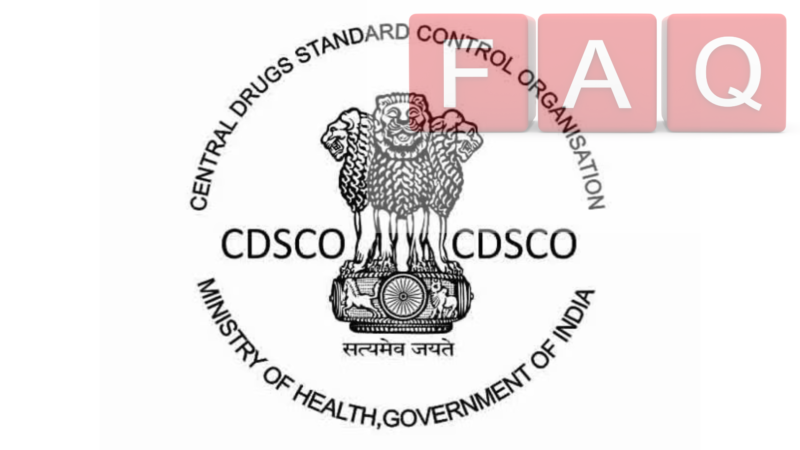This article talks about the recently published FAQs by CDSCO and is structured under clear headings for better readability and understanding. In the dynamic landscape of medical device registration in India, the Central Drugs Standard Control Organization (CDSCO) plays a pivotal role in facilitating a smoother regulatory journey for manufacturers and importers. With initiatives like the establishment of a dedicated email address for regulatory guidance, the CDSCO shows its commitment to innovation and simplification of the approval process. Morulaa HealthTech emerges as a key partner for stakeholders, offering expert advice and solutions tailored to navigate the CDSCO’s regulatory framework.
CDSCO’s Commitment to Supporting Manufacturers
The CDSCO has introduced startupinnov@cdsco.nic.in, a dedicated email address, to provide regulatory guidance to the medical device industry. This initiative amongst the others mentioned in FAQs by CDSCO is part of the CDSCO’s broader efforts to support innovation and ease the regulatory pathway for both startups and established companies, demonstrating a significant stride towards fostering a supportive environment for medical device registration in India.
Separate Fees for Each Brand
For medical device manufacturers and importers, grasping the nuances of MDR-2017 is crucial. One key requirement emphasized in the FAQs by CDSCO is the need for separate fee submissions for each brand when applying for manufacturing or import licenses. Moreover, the process for acquiring an Import License for various purposes, including clinical investigations and testing, is detailed in Form MD-17, highlighting the three-year validity of licenses issued under this form.
Regulatory Requirements for Company Changes and e-IFU
MDR-2017 outlines specific procedures for a “change of constitution” within a company, necessitating a fresh license application to ensure compliance. Additionally, the acceptance of Electronic Instructions for Use (e-IFU) marks a step towards embracing digitalization, aligning with global trends and regulatory standards as outlined in the FAQs by CDSCO..
Post Marketing Surveillance (PMS) and Device Classification
The submission of Post Marketing Surveillance (PMS) data by license holders is a critical aspect of the regulatory framework, ensuring the continuous assessment of device safety and efficacy after market entry. For devices or components not covered in the existing risk classification, manufacturers can request a classification from the Central Licensing Authority, providing detailed technical documents and international regulatory status.
When a medical device’s classification is unclear, manufacturers can request a classification from the Central Licensing Authority, providing technical documents and information on the device’s regulatory status in other countries. For legal manufacturers with multiple manufacturing sites for a specific product, it is possible to include these sites in the existing Import license through endorsement. Morulaa’s team can guide companies through these processes, ensuring that all regulatory requirements are met efficiently.
Import License Inclusions and Importation Protocols
For manufacturers with multiple manufacturing sites for a specific product, the regulations allow the inclusion of these sites in the existing Import license, contingent on the submission of necessary documents and fees. The regulation also specifies that medical devices with a valid Import License must be imported through notified ports under the Drug Rules, 1945, emphasizing the importance of adhering to importation protocols.
Massagers and Therapeutic Devices
Massagers designed solely for relaxation or wellness do not fall under the Medical Devices Rules, 2017, unless they are explicitly marketed for therapeutic uses, such as disease alleviation. This distinction is critical for manufacturers to understand when determining the regulatory pathway for their products. Companies looking to market their massagers for therapeutic purposes must ensure compliance with the rules, a process where Morulaa’s expertise can significantly aid in obtaining the necessary CDSCO regulatory approval.
Software as a Medical Device (SaMD)
SaMD, or standalone software that functions as a medical device, is subject to specific regulatory requirements, including labeling. Manufacturers must adhere to these requirements to ensure their products can be legally marketed in India. Morulaa can provide guidance on the intricacies of these regulations, ensuring that SaMD products meet all necessary standards for approval.
Licenses and Prototypes
For manufacturers and importers working on innovative medical devices, obtaining a Test license is a prerequisite for testing prototypes. This includes MD-13 for manufacturing within India and MD-17 for importing devices into the country. Morulaa’s services include assisting with the acquisition of these licenses, ensuring that prototypes can be legally tested according to the Medical Devices Rules, 2017.
Understanding Accessories, Spare Parts, and Components
The Medical Devices Rules, 2017, provide specific definitions that help differentiate between accessories, spare parts, and components of medical devices. Also these must be listed in the manufacturers IFU and Technical File
- Accessories are defined as devices intended by their manufacturer to be used in combination with one or several specific medical devices to enable or enhance their use. To market an accessory individually, manufacturers must adhere to the Medical Devices Grouping Guideline, including submitting the necessary documentation and fees for the primary device(s).
- Spare Parts are identified as components designed to replace a defective or worn part of a medical device, aiming to maintain or restore the device’s intended function without altering its performance, safety, or intended use. If a spare part changes any of these aspects, it is regulated as a medical device under the Medical Devices Rules, 2017.
- Components refer to any material, part, software, or assembly intended for inclusion in the final packaged medical device. These elements are integral to the construction and functionality of medical devices and must meet regulatory requirements to ensure the overall safety and effectiveness of the device.
Morulaa HealthTech: Navigating Regulatory Challenges
Morulaa HealthTech offers invaluable support to manufacturers and importers in navigating the CDSCO’s regulatory environment. With a deep understanding of the MDR-2017 and a strategic approach to compliance, Morulaa provides comprehensive assistance, from license application processes to compliance with post-marketing requirements, and guidance through changes in company constitution and device classification. Morulaa’s expertise ensures a smooth regulatory journey, enabling successful market entry for medical devices in India. To get in touch please email us on admin@morulaa.com or Click Here.

